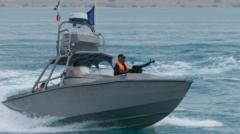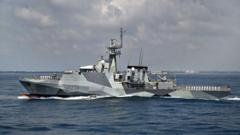In recent developments, China has placed considerable structures in the shared waters of the Yellow Sea, which it claims are deep-sea fish farms. However, these installations have sparked apprehension in South Korea regarding their potential military uses. The South Korean National Assembly’s fisheries committee have condemned these structures as a "threat to maritime safety," echoing worries raised by military veterans and reports from strategic think tanks. Observations liken these installations to China's actions in the South China Sea, where civilian structures evolved into military outposts, fostering territorial disputes. The situation poses a significant challenge for South Korea’s new president, Lee Jae Myung, as he navigates improving ties with Beijing while strengthening the alliance with Washington, especially ahead of the upcoming APEC summit in Gyeongju.
China's Fish Farms in the Yellow Sea Raise Military Concerns in South Korea

China's Fish Farms in the Yellow Sea Raise Military Concerns in South Korea
South Korean officials express fears that China's recent maritime installations are not solely for aquaculture, suggesting military implications amid intricate regional tensions.
In recent years, China has towed a decommissioned offshore oil-drilling rig and two giant octagonal steel cages into the sea between China and South Korea, stating their purpose is deep-sea fish farming. Yet, these structures have stirred fear in South Korea that they might serve a more ominous purpose—enhancing China’s military reach in shared waters.
On Monday, South Korea's National Assembly addressed the concern, with the ocean and fisheries committee taking a strong stance against the Chinese installations. They labeled the structures as “a threat to maritime safety” and passed a resolution with bipartisan approval. This reaction comes on the heels of a report from the Center for Strategic and International Studies in Washington, D.C., which raised alarms about the dual-use potential of these platforms. It emphasizes that although the platforms appear focused on aquaculture, there is a legitimate basis for concern given China’s history in the South China Sea.
The report utilized satellite imagery and other relevant data to detail the implications of the installations. It highlighted that, regardless of further development, the structures are likely already gathering information valuable for underwater navigation and detection capabilities.
South Koreans are drawing parallels between these new Chinese platforms in the Yellow Sea—known as the West Sea in Korea—and prior actions taken by Beijing in the South China Sea. There, China transformed initially civilian-focused artificial islands into military strongholds, sparking territorial disputes with nations such as the Philippines and Vietnam.
The escalating tensions surrounding the Chinese maritime installations now emerge as a pivotal issue for the newly inaugurated President Lee Jae Myung. He has expressed intentions to enhance relations with Beijing while simultaneously buttressing South Korea's alliance with Washington. President Lee aims to engage with China's leadership during the upcoming Asia-Pacific Economic Cooperation summit set for November in Gyeongju, South Korea. As regional dynamics evolve, the challenge remains in balancing these critical diplomatic ties while safeguarding national security.
On Monday, South Korea's National Assembly addressed the concern, with the ocean and fisheries committee taking a strong stance against the Chinese installations. They labeled the structures as “a threat to maritime safety” and passed a resolution with bipartisan approval. This reaction comes on the heels of a report from the Center for Strategic and International Studies in Washington, D.C., which raised alarms about the dual-use potential of these platforms. It emphasizes that although the platforms appear focused on aquaculture, there is a legitimate basis for concern given China’s history in the South China Sea.
The report utilized satellite imagery and other relevant data to detail the implications of the installations. It highlighted that, regardless of further development, the structures are likely already gathering information valuable for underwater navigation and detection capabilities.
South Koreans are drawing parallels between these new Chinese platforms in the Yellow Sea—known as the West Sea in Korea—and prior actions taken by Beijing in the South China Sea. There, China transformed initially civilian-focused artificial islands into military strongholds, sparking territorial disputes with nations such as the Philippines and Vietnam.
The escalating tensions surrounding the Chinese maritime installations now emerge as a pivotal issue for the newly inaugurated President Lee Jae Myung. He has expressed intentions to enhance relations with Beijing while simultaneously buttressing South Korea's alliance with Washington. President Lee aims to engage with China's leadership during the upcoming Asia-Pacific Economic Cooperation summit set for November in Gyeongju, South Korea. As regional dynamics evolve, the challenge remains in balancing these critical diplomatic ties while safeguarding national security.





















